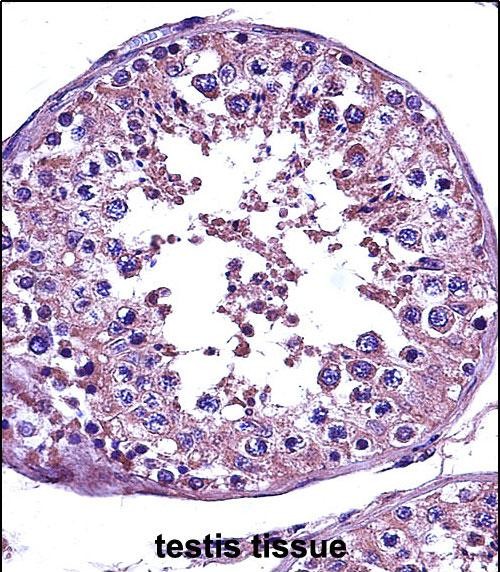STAT4 Antibody (C-term)
Affinity Purified Rabbit Polyclonal Antibody (Pab)
- SPECIFICATION
- CITATIONS
- PROTOCOLS
- BACKGROUND

Application
| IHC-P, IF, WB, E |
|---|---|
| Primary Accession | Q14765 |
| Other Accession | P42228, NP_003142.1 |
| Reactivity | Human |
| Predicted | Mouse |
| Host | Rabbit |
| Clonality | Polyclonal |
| Isotype | Rabbit IgG |
| Calculated MW | 85941 Da |
| Antigen Region | 666-695 aa |
| Gene ID | 6775 |
|---|---|
| Other Names | Signal transducer and activator of transcription 4, STAT4 |
| Target/Specificity | This STAT4 antibody is generated from rabbits immunized with a KLH conjugated synthetic peptide between 666-695 amino acids from the C-terminal region of human STAT4. |
| Dilution | IHC-P~~1:10~50 IF~~1:10~50 WB~~1:1000 E~~Use at an assay dependent concentration. |
| Format | Purified polyclonal antibody supplied in PBS with 0.09% (W/V) sodium azide. This antibody is purified through a protein A column, followed by peptide affinity purification. |
| Storage | Maintain refrigerated at 2-8°C for up to 2 weeks. For long term storage store at -20°C in small aliquots to prevent freeze-thaw cycles. |
| Precautions | STAT4 Antibody (C-term) is for research use only and not for use in diagnostic or therapeutic procedures. |
| Name | STAT4 |
|---|---|
| Function | Transcriptional regulator mainly expressed in hematopoietic cells that plays a critical role in cellular growth, differentiation and immune response (PubMed:10961885, PubMed:37256972, PubMed:8943379). Plays a key role in the differentiation of T-helper 1 cells and the production of interferon-gamma (PubMed:12213961, PubMed:35614130). Also participates in multiple neutrophil functions including chemotaxis and production of the neutrophil extracellular traps (By similarity). After IL12 binding to its receptor IL12RB2, STAT4 interacts with the intracellular domain of IL12RB2 and becomes tyrosine phosphorylated (PubMed:10415122, PubMed:7638186). Phosphorylated STAT4 then homodimerizes and migrates to the nucleus where it can recognize STAT target sequences present in IL12 responsive genes. Although IL12 appears to be the predominant activating signal, STAT4 can also be phosphorylated and activated in response to IFN-gamma stimulation via JAK1 and TYK2 and in response to different interleukins including IL23, IL2 and IL35 (PubMed:11114383, PubMed:34508746). Transcription activation of IFN-gamma gene is mediated by interaction with JUN that forms a complex that efficiently interacts with the AP-1-related sequence of the IFN-gamma promoter (By similarity). In response to IFN- alpha/beta signaling, acts as a transcriptional repressor and suppresses IL5 and IL13 mRNA expression during response to T-cell receptor (TCR) activation (PubMed:26990433). |
| Cellular Location | Cytoplasm. Nucleus. Note=Translocated into the nucleus in response to phosphorylation. |

Thousands of laboratories across the world have published research that depended on the performance of antibodies from Abcepta to advance their research. Check out links to articles that cite our products in major peer-reviewed journals, organized by research category.
info@abcepta.com, and receive a free "I Love Antibodies" mug.
Provided below are standard protocols that you may find useful for product applications.
Background
The protein encoded by this gene is a member of the STAT family of transcription factors. In response to cytokines and growth factors, STAT family members are phosphorylated by the receptor associated kinases, and then form homo- or heterodimers that translocate to the cell nucleus where they act as transcription activators. This protein is essential for mediating responses to IL12 in lymphocytes, and regulating the differentiation of T helper cells.
References
Plant, D., et al. Ann. Rheum. Dis. 69(8):1548-1553(2010)
Gestermann, N., et al. Genes Immun. 11(5):432-438(2010)
Schuurhof, A., et al. Pediatr. Pulmonol. 45(6):608-613(2010)
Vuong, M.T., et al. PLoS ONE 5 (5), E10559 (2010) :
Glas, J., et al. PLoS ONE 5 (4), E10373 (2010) :
If you have used an Abcepta product and would like to share how it has performed, please click on the "Submit Review" button and provide the requested information. Our staff will examine and post your review and contact you if needed.
If you have any additional inquiries please email technical services at tech@abcepta.com.













 Foundational characteristics of cancer include proliferation, angiogenesis, migration, evasion of apoptosis, and cellular immortality. Find key markers for these cellular processes and antibodies to detect them.
Foundational characteristics of cancer include proliferation, angiogenesis, migration, evasion of apoptosis, and cellular immortality. Find key markers for these cellular processes and antibodies to detect them. The SUMOplot™ Analysis Program predicts and scores sumoylation sites in your protein. SUMOylation is a post-translational modification involved in various cellular processes, such as nuclear-cytosolic transport, transcriptional regulation, apoptosis, protein stability, response to stress, and progression through the cell cycle.
The SUMOplot™ Analysis Program predicts and scores sumoylation sites in your protein. SUMOylation is a post-translational modification involved in various cellular processes, such as nuclear-cytosolic transport, transcriptional regulation, apoptosis, protein stability, response to stress, and progression through the cell cycle. The Autophagy Receptor Motif Plotter predicts and scores autophagy receptor binding sites in your protein. Identifying proteins connected to this pathway is critical to understanding the role of autophagy in physiological as well as pathological processes such as development, differentiation, neurodegenerative diseases, stress, infection, and cancer.
The Autophagy Receptor Motif Plotter predicts and scores autophagy receptor binding sites in your protein. Identifying proteins connected to this pathway is critical to understanding the role of autophagy in physiological as well as pathological processes such as development, differentiation, neurodegenerative diseases, stress, infection, and cancer.




